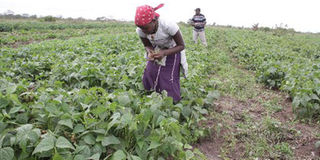Report paints bittersweet outlook as tourism, agriculture take a hit

A farmer harvests french beans at Ngare Ng'iro in Laikipia North on December 3, 2013. Though agriculture recorded a decline, it is still by far the largest contributor to the economy at 25.3 per cent and the largest employer in the country. PHOTO/FILE
What you need to know:
- Latest forecasts indicate that the economy generated 742,000 thousand jobs compared to 659,000 thousand jobs last year and most of them are in the private sector.
- Growth in private sector jobs grew fastest last year compared with any other time in the past five years. This is an encouraging fact at a time when the government is thinking of reducing the number of public service workers.
The 2013 economic survey presented a mixed bag of fortunes for Kenya.
GDP growth improved compared to 2012 despite 2013 being an election year and setting into motion the devolved system of government.
The numbers are improving. Forecast for growth for the next year is expected to grow.
At 4.7 per cent growth in 2013, Kenya’s economic growth was slower than either the regional average or the continental average. Sub-Saharan Africa and the East African Community (EAC) expanded by 5.0 and 6.1 per cent respectively in 2013.
Although the general picture is buoyant, Kenya endured several economic shocks in 2013. Terrorist attacks affected tourism and the money markets dried up.
JOB CREATION
Government borrowing surged upwards as did interest rates, the rains did not come on time and there was reduced spending by government agencies.
Agriculture and wholesale and retail trade are some of the sectors that recorded minimal decline, while the manufacturing, construction and transport sectors registered steady growth.
Though agriculture recorded a decline, it is still by far the largest contributor to the economy at 25.3 per cent and the largest employer in the country.
Latest forecasts indicate that the economy generated 742,000 thousand jobs compared to 659,000 thousand jobs last year and most of them are in the private sector.
Growth in private sector jobs grew fastest last year compared with any other time in the past five years. This is an encouraging fact at a time when the government is thinking of reducing the number of public service workers.
The private sector seems capable of coping with some of the slack from the public sector.
Tourism numbers meanwhile fell markedly. For the second year running, the number of tourists to the country dropped. In 2011, 1.8 million tourists visited the country while last year, the numbers dropped to 1.5 million.
The decline in international arrivals has been attributed to travel advisories by traditional tourist markets due to security concerns. Several security incidents were recorded in 2013, with the Westgate attack as the most notable.
AT A GLANCE
The highs and lows in survey
Exports: Volumes declined while the global prices of tea, coffee and horticulture also fell, which means Kenya spent more on imports than it earned from exports.
Health: Survey listed pneumonia as the top killer among children.
Breast and cervical cancers were ranked as the biggest killers among women, while prostate, oesophagus and Kaposi’s sarcoma were the leading killers among men.
Industry: There was an increase in the manufacture of cement, rubber and sugar but drop in fish processing.





